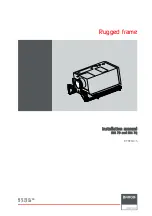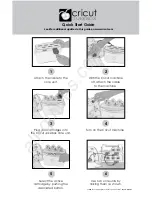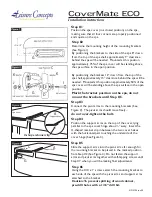
OPERATION INSTRUCTIONS
FOR NEXSYS
®
iON BATTERIES
2
TABLE OF CONTENTS
1.
Scope ................................................................................... 2
2.
Operational Data and Limits .............................................. 2
3.
Safety ................................................................................ 2-3
4.
Usage ................................................................................... 3
5.
Environmental Operation Limits ....................................... 3
6.
Fire Extinguishing ............................................................... 3
7.
Safety Venting .................................................................... 3
8.
Handling .............................................................................. 4
9.
Battery Architecture .......................................................... 4
10.
Mechanical Installation into Industrial Truck ................... 4
11.
Electrical Power Connection to Industrial Truck .............. 4
12.
Battery Communication Intrefaces
With Charger Truck and Operator Interfaces.................... 4
13.
Operator Interfaces ......................................................... 5-6
14.
Canbus Connectivity .......................................................... 6
15.
Activation / Deactivation of Battery ................................. 6
16.
Charging Battery ................................................................ 7
17.
Technical Parameters ..................................................... 7-8
18.
Transport ............................................................................ 8
19.
Storage ............................................................................... 8
20.
Service and Maintenance ................................................. 8
21.
Dismantling ........................................................................ 8
22.
Disposal and Recycling ..................................................... 8
23.
Troubleshooting ............................................................. 8-9
24.
Appendix A: Ratings Table ............................................. 10
25.
Terms and Abbreviations...................................................10
1. SCOPE
The information contained in this document is critical to the safe handling and proper use
of the NexSys
®
iON Lithium-ion (Li-ion) battery for powering of electrical industrial trucks.
It contains a global specification of the system as well as related safety measures, code
of behavior, a guideline for commissioning and recommended maintenance. It must be
retained and available for users working with and responsible for the battery. All users
are responsible for ensuring that all applications of the system are appropriate and safe
based on conditions anticipated or encountered during use.
While EnerSys
®
has used reasonable endeavors towards the application of legal
requirements, this documentation is not legal advice and should not be relied upon as
such. It is the users’ responsibility to ensure the use of the documentation and any
activities related thereto to follow all legal requirements applicable to themselves and
the applications in the respective countries.
This document is also not intended to substitute any training for handling and operating
the industrial truck or NexSys iON battery that may be required by local laws and/or
industry standards. Proper instruction and training of all users must be ensured prior to
any contact with the battery system.
NexSys iON batteries are designed for industrial truck traction applications only. Only
EnerSys approved chargers are to be used to charge NexSys iON batteries.
Refer to the abbreviations and terms at the end of this document.
2. OPERATIONAL DATA AND LIMITS
Nominal capacity C
1
: see APPENDIX A: RATINGS TABLE
Nominal voltage: 25.55V, 36.50V, 51.10V, see APPENDIX A: RATINGS TABLE
Discharge current (continuous): 1C
1
, up to a max of 320 A
(limited by traction cable harness)
Max charge current (continuous): 1C
1
up to a max of 640 A
(limited by charging cable harness(s))
2. OPERATIONAL DATA AND LIMITS (CONTINUED)
Rated operational battery temperature range:14°F (-10°C) to 131°F (55°C)
(battery temperature)
Rated charging battery temperature range: 32°F (0°C) to 122°F (50°C)
(battery temperature)
This battery must not be used under conditions where it becomes immersed in water.
This battery must not be installed on the underbody of an electrical industrial truck.
Usage of this battery in cold store applications must be verified and approved in writing
by EnerSys Engineering.
Storage of this battery at cold temperatures below the battery operating temperature
must not be allowed.
Usage or storage of this battery in ambient temperatures above the battery operating
range must not be allowed.
Product is neither intended to be permanently stored nor used exclusively outdoors
unless truck is designed for it.
Battery is designed to be charged indoors in the truck.
Failure to follow these Operation Instructions can result in serious damage to the battery
and may result in serious injury. Failure to follow these Operation Instructions or using
parts that are non-original will void the NexSys iON battery warranty.
These batteries are maintenance free.
Only EnerSys approved fasteners, connectors, cabling and plugs to be used.
3. SAFETY
This battery is designed to be a drop-in replacement of a lead-acid battery used to
power an electric industrial truck. Modifications of truck firmware, truck settings
or truck hardware may be necessary with the substitution of the lead acid battery
to accommodate the Lithium-ion battery. Consult with Truck OEM for required
modifications. Depending on the intended application, connectors, ballast, tray size, etc.,
must be customized in order to ensure the drop-in compatibility. The instructions of the
operational manual of the industrial truck must be followed.
Each battery is designed to be stable and tolerant to the applications within the scope
laid out in the operating conditions, however, battery systems have an inherent hazard
due to the nature of stored energy.
All limits of the vehicle including operating and handling for the vehicle must be followed
in addition to the battery limits as documented in the following sections for a safe
operation, handling and storage.
Anybody involved in handling or usage of the battery must completely understand
and be trained on all aspects of the battery systems as required by local laws and
regulations.
The battery is an electrical storage system. During operation and charging the DC
voltage will be 19.6 to 29.4, 28.0 to 42.0 or 39.2 to 58.8 volts for the 24V, 36V and 48V
batteries respectively.
In case the battery shuts down with a message that indicates “Battery Lockout”
EnerSys must be contacted for service as the pack is locked out until a service person is
able to inspect the battery and then return it to Service.
In the instance that the mechanical integrity of the battery is compromised (e.g.
penetration of case, rupture of case, etc.) do not use battery and contact EnerSys
Service.
The main potential dangers of this battery are:
Thermal Events
: An event with high temperatures within the cell(s) which can possibly
include release of flammable, corrosive and toxic liquids/gasses, smoke containing
components such as hydrofluoric acid and carbon monoxide. Avoid prolonged exposure.
In case of fire, reference Chapter 6.
Short Circuits with Arc Flashes
: A shorting event with a high current may occur
because of the low internal resistance of the Lithium-ion battery. A resulting arc flash
may emit an intense hot flash of infrared, visible and ultraviolet light. Molten and
vaporized metal may be ejected. Components may become extremely hot.
Mechanical Hazards
: An event with dropping, crushing, pinching or impact due to the
heavy weight of the battery if improperly handled or restrained.






























